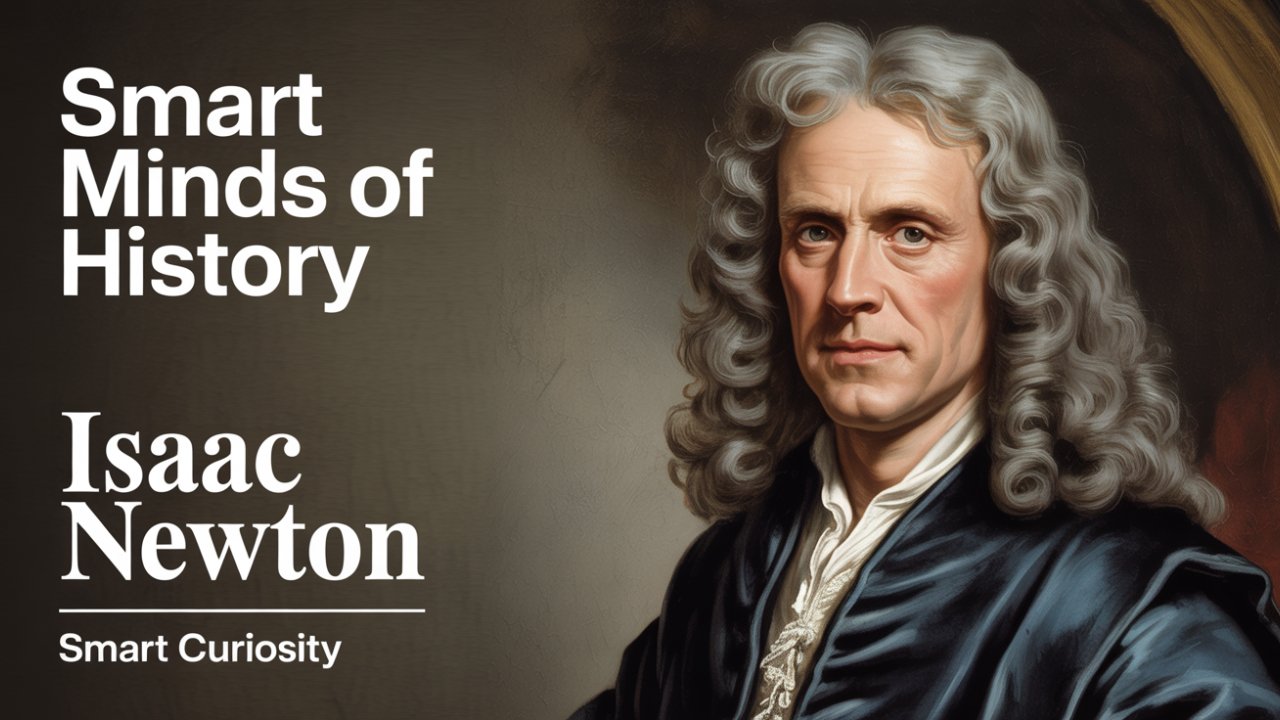Isaac Newton. The name itself just sounds like science. We know him as the father of modern physics, the man of pure, cold reason who saw the universe as a giant, perfect clock. He gave us the laws that run the cosmos, fitting the orbits of planets and the nature of light into neat mathematical boxes. His discoveries aren’t just the bedrock of our world; they’re the very language we use to describe reality itself.
But the mind that unlocked the universe was also obsessed with something else… something darker and more mysterious. What if I told you that history’s greatest scientist was also, perhaps, its last great sorcerer? The man who built our modern world spent more time, and wrote far more pages, on the forbidden art of alchemy and decoding biblical prophecy than he ever did on motion and gravity.
This is the story of a divided soul. A man of logic and a man of faith. A reclusive genius and a ruthless tyrant. This is the story of how a lonely, solitary thinker from a small English village laid the groundwork that would redefine our universe.
The Lonely Beginning
Our story begins on Christmas Day, 1642, in the quiet English hamlet of Woolsthorpe. At least, that was the date on the Julian calendar they were using back then. For us, it would be January 4th, 1643. It was a time of chaos, with the English Civil War tearing the country apart. Into this turmoil, a child was born so small and weak, he wasn’t expected to survive the day. His father, also named Isaac, had died three months earlier. The baby was named in his honor a tiny, fragile monument to a man he’d never know.
This profound sense of loss was the first shadow to fall across Newton’s life. The second came just three years later when his mother, Hannah, remarried a wealthy clergyman and moved away, leaving young Isaac with his grandmother. For a child, this was an abandonment that would fester into a lifelong pattern of isolation, deep suspicion, and an inability to trust anyone. From his earliest days, he was utterly alone. That solitude became his laboratory, his sanctuary, and his prison.
By all early accounts, he wasn’t a promising student. He was often described as “idle” and “inattentive.” His mind was just… elsewhere. While other boys played, Isaac was building intricate models: a tiny windmill that could actually grind flour, powered by a mouse on a treadmill; water clocks that kept perfect time; and kites with lanterns tied to their tails, which he’d fly at night to terrify locals into thinking they were comets. These weren’t just toys. They were experiments. He was deconstructing the world, figuring out what made it tick.
His quiet world was shattered by a schoolyard bully who kicked him hard in the stomach. Something inside Newton snapped a deep reservoir of rage and competitive fire. He challenged the boy to a fight and, though smaller, thrashed him. But that wasn’t enough. Newton’s desire for revenge was absolute. He decided he had to crush his rival intellectually, too. From that day on, he applied himself with a ferocious intensity, quickly becoming the top student. It was the first real glimpse of the relentless, unforgiving drive that would define his life. He wasn’t content to be right; he had to prove everyone else wrong.
His mother, now widowed a second time, had other plans. She pulled him from school at seventeen to manage the family farm. It was a total disaster. Newton hated farming. He’d be found reading under a hedge when he should have been tending sheep. His uncle and the school’s master saw his wasted potential and convinced his mother to let him return to his studies. In 1661, Isaac Newton, the lonely boy who built models and fought bullies, packed his bags for Trinity College, Cambridge, ready to step onto the stage of intellectual history.
The Halls of Cambridge
Cambridge in the 1660s was a world caught between two ages. The official curriculum was a relic, still dominated by the ancient philosophy of Aristotle. Students were taught that the Earth was the center of the universe and that objects fell because they sought their “natural place.”
To Newton, this was just intellectual dust. It was unsatisfying, lacking mathematical proof. He quickly mastered the required texts, but his real education took place in private. He devoured the works of the great minds of the Scientific Revolution: Descartes, who imagined a mechanical universe; Kepler, who had described the elliptical orbits of the planets; and Galileo, who had shattered the idea of celestial perfection.
This was the frontier of human knowledge, and Newton was determined to push it. He bought a notebook and titled it: “Quaestiones Quaedam Philosophicae,” or “Certain Philosophical Questions.” This notebook became the crucible of his genius. In it, he systematically challenged everything, organizing his thoughts into 45 headings: “Of Matter,” “Of Light,” “Of Colour,” “Of Motion.” He wasn’t just learning; he was questioning. Why does gravity extend so far? Is light a particle or a wave? What is the fundamental nature of time and space? These were the questions that would drive him for the rest of his life.
His time at Cambridge was one of monk-like devotion. He was an invisible student, so focused he often forgot to eat or sleep. There are stories of meals being left untouched and of him stumbling through the college grounds, his mind on another plane of existence. His focus was absolute. He wrote in one notebook, “Plato is my friend, Aristotle is my friend, but my best friend is truth.”
He was building an intellectual toolkit no one had ever possessed. But he was still using tools others had given him. He was a brilliant student of the new science, but not yet its master. He was on the cusp of a revolution, but he didn’t know it. The world didn’t know it. And then, in 1665, the world shut down. The Great Plague swept across England, and Cambridge closed its doors. Newton was forced back to the isolation of his childhood home. For most, this was a time of fear. For Isaac Newton, it was the beginning of a miracle.
The Year of Wonders (Annus Mirabilis)
For the next 18 months, while the plague raged, Isaac Newton entered a period of creative explosion unparalleled in the history of science. In the solitude of his family farm, free from the rigid curriculum of Cambridge, his mind was finally unleashed. He would later call these his “annus mirabilis,” the “year of wonders,” and “the prime of my age for invention.” In this short span, working almost entirely alone, he laid the foundations for three fields of knowledge.
His first breakthrough was in mathematics. The science of the day was static; it could describe a line or an area, but not a world in constant motion. How do you calculate the exact speed of a cannonball at a single instant? The existing math was a photograph; Newton needed a moving picture.
So, he created one. He developed what he called the “Method of Fluxions.” Today, we know it as calculus. It was a revolutionary new language that could describe change, motion, and infinity. He had built the mathematical engine needed to drive the next 300 years of science. And for now, he told absolutely no one. It remained hidden in his notebooks.
His second wonder was in optics. For millennia, the nature of light and color was a mystery. The prevailing theory was that white light was pure, and colors were just modifications of it. Newton decided to test this. In a dark room, he let a single beam of sunlight pass through a prism. The light fanned out into a brilliant rainbow. But Newton took a crucial, ingenious next step, what he called his experimentum crucis the critical experiment. He isolated a single color from that spectrum say, red and passed it through a second prism. According to the old theory, it should have changed color again. It didn’t. Red light came out as pure red. Then, he used a lens to recombine the entire scattered spectrum. The result? A perfect beam of white light. The conclusion was irrefutable: white light wasn’t pure. It was a mixture of all the colors, which were fundamental properties of light itself. He had decoded the rainbow.
The third and most famous insight concerned the fabric of the cosmos. The story of the falling apple is likely embellished, but it points to a world-changing question. Seeing an apple fall, Newton wondered: what is this force, gravity? How far does it extend? Does it reach the tops of the mountains? Does it reach all the way to the Moon?
And there it was. The leap of genius. No one before had seriously thought that the mundane force pulling an apple to the ground was the exact same force that governed the majestic dance of the heavens. Newton’s radical idea was that there was only one universe, governed by one set of universal laws. He proposed that the same gravity that pulled the apple from its branch also held the Moon in orbit, constantly yanking it from a straight path into a circle. He did a rough calculation based on an “inverse square law” double the distance, and the force becomes four times weaker. His math was close, but not yet perfect. Still, the core idea was there: universal gravitation.
Calculus, the nature of light, and universal gravitation. All conceived by one man in less than two years of forced isolation. It was an outpouring of creative genius without equal. Yet, when the plague subsided and the universities reopened in 1667, Newton returned to Cambridge and said almost nothing. The greatest scientific secrets in the world were locked away in his notebooks, and in the silent fortress of his mind.
The Reluctant Revolutionary
Back at Cambridge, Newton’s brilliance was quickly recognized. In 1669, at the astonishing age of 26, he was appointed the Lucasian Professor of Mathematics, a chair he would hold for over 30 years. He was now a leading academic, yet he remained intensely secretive about his most profound discoveries.
Why the silence? Newton was pathologically averse to criticism. He was a perfectionist, but more than that, he loathed intellectual conflict. To publish his work was to invite challenges, an experience he found unbearable.
His first taste of the public arena came from a practical invention. In 1668, he built the world’s first functioning reflecting telescope. Standard telescopes used lenses, which created blurry, colored halos a problem Newton understood because he knew white light was a mix of colors. His ingenious solution was to use a curved mirror instead. His prototype was tiny but incredibly powerful.
He was asked to show it to the Royal Society of London, the country’s top scientific body. The demonstration was a sensation, and Newton was elected a Fellow in 1672. But his triumph quickly turned sour. Emboldened, Newton submitted a paper on his theory of light and color. It came under the scrutiny of one of the Society’s most powerful figures: Robert Hooke.
Hooke was brilliant, ambitious, and fiercely jealous of his reputation. He had his own theory of light and immediately, publicly, dismissed Newton’s work as unproven. For Newton, this wasn’t a debate; it was a personal attack. He wrote furious, defensive letters, and soon found himself in the exact kind of public squabble he dreaded. The experience was so traumatic that after a period of extreme emotional distress, which some historians have called a nervous breakdown, he withdrew almost entirely from public intellectual life. He vowed never to publish again. For nearly a decade, he retreated into his shell at Cambridge, a silent giant sitting on a treasure trove of world-changing knowledge. And in that silence, his mind turned to much older, and much stranger, pursuits.
The Secret Life of a Genius
This is where the neat story of Isaac Newton, the coolly rational scientist, falls apart. As he withdrew from public science, he dove deeper into a hidden world of ancient mysticism a world he saw as essential to his quest for knowledge. We see him as the man who created a predictable, mechanical universe. But Newton saw himself as someone rediscovering divine knowledge, deciphering God’s two books: the book of Nature, and the book of Scripture.
His greatest secret obsession was alchemy. This wasn’t a casual hobby. Over his life, he wrote more than a million words on it far more than he ever wrote on physics. He wasn’t just trying to turn lead into gold. He believed alchemical texts, with their strange symbols, held the key to understanding the fundamental structure of matter. He was searching for an active principle, a life force he believed God used to design the universe.
Alongside this, Newton harbored even more dangerous secrets: his religious beliefs. Privately, he was a radical heretic. After an exhaustive study of the Bible, he concluded that the Holy Trinity a central doctrine of Christianity was a fraud. This belief, known as Arianism, was a profound heresy. If he’d gone public, it would have cost him his career and put him in serious danger.
His religious studies went even further. Newton was convinced the Bible was a prophetic book written in a divine code. He spent countless hours and filled thousands of pages trying to create a precise timeline of world history and calculate the exact date of the apocalypse. To him, there was no contradiction here. Calculating a comet’s orbit and the date of the Second Coming were two sides of the same coin: an attempt to read the mind of God.
This was the hidden Newton. The man who saw God’s handiwork in a prism was also searching for the Philosopher’s Stone. He wasn’t a modern scientist trapped in a pre-modern world. He stood with one foot in the new world of reason and experiment, and the other firmly planted in the ancient world of magic and prophecy. It would take a friend’s intervention to pull him out of his mystical studies and force him to give his greatest discovery to the world.
The Principia: A Book That Changed the World
In August 1684, Newton’s quiet, alchemical seclusion was interrupted by a visitor from London: Edmond Halley, a brilliant young astronomer. Halley was obsessed with a question vexing the scientific community: what path would a planet take if it were pulled toward the sun by an inverse-square force?
Halley had already asked Robert Hooke, who bragged he had the answer but refused to share it. Frustrated, Halley journeyed to Cambridge to ask the reclusive professor. Newton’s response was immediate and stunning. “An ellipse,” he replied. Halley was floored and asked to see the calculations. Newton shuffled through his chaotic papers but couldn’t find them. He promised to redo the work and send it along.
This visit lit a fuse. A few months later, a nine-page paper arrived in London. Halley realized at once it was something monumental. He rushed back to Cambridge and begged Newton to develop his ideas fully for publication.
Fueled by Halley’s encouragement, Newton plunged into one of the most intense periods of intellectual labor in human history. For the next two years, he worked with a manic, almost inhuman focus, barely eating or sleeping.
The result was the Philosophiæ Naturalis Principia Mathematica the “Mathematical Principles of Natural Philosophy.” Published in 1687 and paid for by the loyal Halley, the Principia is arguably the single most important scientific book ever written.
It’s built on his three laws of motion: inertia, F=ma, and action-reaction. These simple, elegant laws provided the fundamental rules for all mechanics. Upon this foundation, Newton built his masterpiece: the law of universal gravitation. He mathematically demonstrated that every particle in the universe attracts every other particle with a force that could be precisely calculated. This was the law he had first conceived with the apple, now proven with unassailable math. It explained not just a falling apple, but the orbits of planets, the paths of comets, and even the rhythm of the tides. He had unified the heavens and the Earth under a single mathematical principle.
The Principia presented a vision of the universe not as a place of mystery, but as a vast, intricate, and predictable machine, running according to discoverable laws. The lonely scholar from Woolsthorpe had given humanity the blueprint for the universe.
Rivalry and Revenge
The Principia‘s triumph should have been Newton’s moment of glory. Instead, it dragged him into the most bitter intellectual war of his life. His rival was not Hooke, but an equal titan: the German philosopher and mathematician Gottfried Wilhelm Leibniz.
While Newton was secretly developing his “Method of Fluxions” in the 1660s, Leibniz, working independently, had developed his own, remarkably similar system. He called it “calculus” and published his work in 1684 years after Newton’s invention, but years before Newton published it.
At first, the two men were respectful. But as the power of calculus became clear, the question of who invented it first became an issue of national pride. Newton’s supporters whispered that Leibniz had stolen the ideas. The conflict exploded in the early 1700s when Leibniz appealed to the Royal Society to settle the matter. It was a catastrophic mistake. By now, the president of the Royal Society was Sir Isaac Newton.
Newton wielded his authority with brutal efficiency. He established an “impartial” committee packed with his own supporters. He orchestrated the investigation from behind the scenes. And in a final act of supreme deception, Newton secretly wrote the committee’s final report himself.
The report was a complete condemnation of Leibniz. It declared Newton the sole inventor and shamelessly accused Leibniz of plagiarism. Leibniz’s reputation was shattered. He died a few years later, a broken and largely discredited figure. Today, historians agree they invented calculus independently. But Newton, driven by his pathological hatred of rivals, used his power to crush his opponent and rewrite history. The feud reveals the darkest side of Newton’s character: a man capable of both transcendent genius and petty, unforgiving revenge.
The London Years: Power and Politics
In 1696, Newton left the quiet halls of Cambridge for the bustling world of London. He was no longer a reclusive scholar; he was about to become a powerful man of the establishment. He secured a position as Warden, and later Master, of the Royal Mint, a role he held until his death.
This was no cushy job. At the time, England’s currency was in crisis from widespread counterfeiting. Newton threw himself into the work with obsessive intensity. He oversaw a massive project to reissue the entire currency. But he also became a relentless detective. He went undercover in London’s taverns to gather intelligence, personally interrogated counterfeiters with merciless zeal, and successfully prosecuted dozens of criminals, with several facing the gallows as a result. The mind that had plumbed the cosmos was now untangling criminal conspiracies.
His power only grew. In 1703, after his old rival Robert Hooke died, Newton was elected President of the Royal Society. He ruled it like an autocrat for 24 years, punishing his enemies, most notably Leibniz. In 1705, Queen Anne knighted him. Isaac Newton, the poor farm boy, was now Sir Isaac Newton, a symbol of Britain’s scientific supremacy.
His final decades were spent polishing his great works and continuing his private theological studies. He lived comfortably, but alone, never marrying and having few close friends. He died in his sleep in London on March 20, 1727, at the age of 84. He was given a state funeral and buried in Westminster Abbey, a national hero laid to rest among kings and queens.
It’s almost impossible to overstate Isaac Newton’s legacy. The world he left behind was fundamentally different. His laws of motion and gravitation provided the foundation for classical mechanics, a system so powerful it still underpins much of our modern world. The mathematical tool he co-invented, calculus, became the language of science. More than any single discovery, he gave us a method a way of doing science that combines mathematical rigor with empirical evidence that has inspired scientists for centuries.
He was a man of breathtaking contradictions: the ultimate rationalist who spent decades immersed in alchemy; the reclusive scholar who became a ruthless political operator; the man of deep, unorthodox faith who saw God’s hand in both scripture and the elegant math governing the fall of an apple.
He famously wrote to Robert Hooke, “If I have seen further, it is by standing on the shoulders of giants.” It was a statement of humility, though perhaps also a subtle jab at the shorter Hooke. But in the centuries since, the phrase has been turned back on him. For it is Newton’s own shoulders upon which much of modern science stands. His towering intellect illuminated the deepest mysteries of the universe, and in doing so, he didn’t just change science. He changed the world.
If you want to explore more stories of the revolutionary thinkers who shaped our world, make sure to subscribe and turn on notifications for our next video in the Smart Minds of History series.





